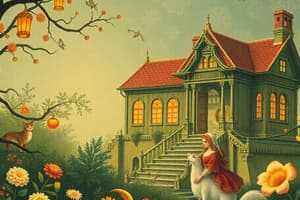Podcast
Questions and Answers
What is the core theme of 'The Little Match Girl'?
What is the core theme of 'The Little Match Girl'?
- The struggles of poverty (correct)
- The power of friendship
- The importance of family bonds
- The pursuit of wealth
How does the Little Match Girl maintain her innocence amidst her dire circumstances?
How does the Little Match Girl maintain her innocence amidst her dire circumstances?
- By indulging in escapism through lighting matches (correct)
- By stealing to survive
- By giving up hope completely
- By seeking revenge on those who neglected her
What do the matches symbolize in 'The Little Match Girl'?
What do the matches symbolize in 'The Little Match Girl'?
- Sorrow and despair
- Hope and a better future (correct)
- Loneliness and isolation
- Prestige and wealth
How do the visions seen by the Little Match Girl as she lights matches affect the story?
How do the visions seen by the Little Match Girl as she lights matches affect the story?
What kind of impact has 'The Little Match Girl' had since its publication?
What kind of impact has 'The Little Match Girl' had since its publication?
Why is 'The Little Match Girl' considered a timeless classic?
Why is 'The Little Match Girl' considered a timeless classic?
What is the central theme of 'The Little Match Girl'?
What is the central theme of 'The Little Match Girl'?
Which of the following fairy tales is NOT written by Hans Christian Andersen?
Which of the following fairy tales is NOT written by Hans Christian Andersen?
How does 'The Little Match Girl' differ from traditional fairy tales?
How does 'The Little Match Girl' differ from traditional fairy tales?
What do Hans Christian Andersen's fairy tales illuminate according to the text?
What do Hans Christian Andersen's fairy tales illuminate according to the text?
Which aspect of Hans Christian Andersen's life is reflected in his work according to the text?
Which aspect of Hans Christian Andersen's life is reflected in his work according to the text?
In 'The Little Match Girl,' what does Andersen's vivid language bring to life?
In 'The Little Match Girl,' what does Andersen's vivid language bring to life?
Flashcards are hidden until you start studying
Study Notes
The Little Match Girl by Hans Christian Andersen: A Tale of Poverty, Innocence, and Symbolism
In the heart of 19th-century literary fairy tales, Hans Christian Andersen's "The Little Match Girl" stands as a poignant and poignantly simple story of childhood innocence and the struggles of poverty. In this brief but impactful narrative, Andersen weaves together themes of suffering, hope, and profound symbolism that continue to resonate with readers today.
Hans Christian Andersen
Born in Denmark in 1805, Hans Christian Andersen is widely recognized as one of the greatest storytellers of all time. His fairy tales, which include classics like "The Ugly Duckling," "The Little Mermaid," and "The Emperor's New Clothes," illuminate the human condition, offering commentaries on life, love, and the human spirit. Andersen's work reflects his own life experiences, including his humble beginnings and his struggles to make a name for himself in the world of literature.
Fairy Tales
"The Little Match Girl" is a quintessential fairy tale, but it departs from the traditional structure we often associate with the genre. Rather than focusing on adventure, romance, or a coming of age narrative, this story delves into the tragedy of hardship and the power of imagination. The tale's simplicity belies its profound impact, as Andersen's vivid and evocative language brings to life the plight of the titular character and her frail hopes for a better future.
Struggles of Poverty
At its core, "The Little Match Girl" is a story about poverty. The protagonist, a young girl, is left to fend for herself in the cold outdoors on New Year's Eve. As she struggles to sell her meager supply of matches to keep warm, the harsh realities of her impoverished life become clear. The girl's story mirrors the hardships faced by many during the Industrial Revolution, when poverty and social inequality were rampant.
Childhood Innocence
Despite her dire circumstances, the Little Match Girl maintains a sense of innocence. In a moment of desperation, she lights matches to see the visions they promise, which appear as apparitions of comfort and warmth: the glowing embers of a cozy fire, the warmth of a loving family, and the promise of a bright future. Her hope and innocence contrast starkly with the harsh realities she faces, providing a poignant and thought-provoking contrast.
Symbolism
Like many of Andersen's fairy tales, "The Little Match Girl" is rich in symbolism. The matches themselves are a powerful symbol of hope, as they light the way to a better future. The visions the Little Match Girl sees as she lights each match represent her deepest desires: the comfort and love she craves, the happiness she longs for, and the future she dreams of. As she reaches her end, the final vision of a warm and loving family evokes a profound sense of sadness and longing.
Impact
"The Little Match Girl" has had a profound impact on readers since its publication in 1845. The tale's simple yet haunting narrative, its vivid language, and its powerful symbolism have resonated with readers for generations. The story has been adapted into numerous animation and live-action films, and it continues to inspire artists, writers, and designers.
Conclusion
Hans Christian Andersen's "The Little Match Girl" is a poignant and powerful fairy tale that explores the struggles of poverty, the innocence of childhood, and the power of symbolism. As a testament to Andersen's skill as a storyteller, the tale continues to resonate with readers long after its original publication. Its simple yet profound narrative, vivid language, and powerful symbolism make it an enduring and timeless classic that will continue to inspire and move readers for generations to come.
Studying That Suits You
Use AI to generate personalized quizzes and flashcards to suit your learning preferences.




